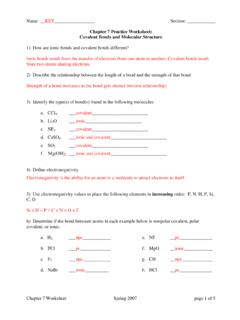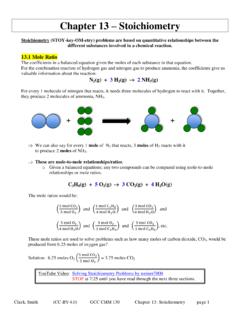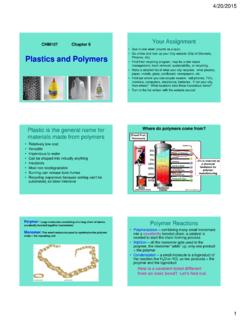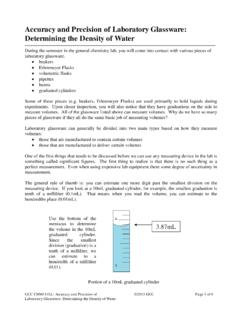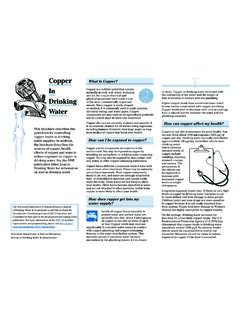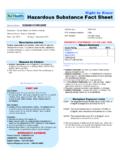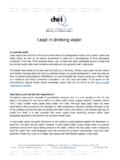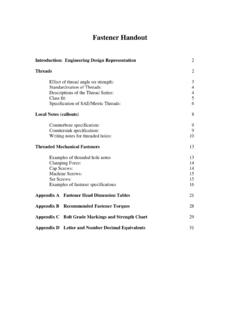Transcription of Density: Accuracy and Precision
1 GCC CHM 151LL: density : Accuracy , and Precision GCC, 2008 page 1 of 5 density : Accuracy and Precision Introduction: density is a measure of a substance s mass-to-volume ratio. For liquids and solids, density is usually expressed in units of g/mL or g/cm3; these are equivalent since 1 mL is exactly equal to 1 cm3. density is an intensive property meaning that a substance s density will be the same regardless of the size of a sample. For example, steel has a density of g/cm3 whether you have a tiny steel ball bearing or a large steel beam. The mass and volume of each piece will be different, but the mass-to-volume ratio is the same! In general, different substances have different densities even if they occupy the same volume or have the same mass.
2 For example, in the opening sequence of Raiders of the Lost Ark, Indiana Jones tries to replace a gold statue with a bag of sand of about the same volume. Even though the volumes may be the same, gold is much more dense than sand. As Indiana Jones found out, ignoring density and only considering volume can have dire consequences. Similarly, two substances may have the same mass but different densities. A classic riddle asks, Which weighs more: a pound of feathers or a pound of gold? The answer seems easy. Since a pound is a pound, they should weigh the same. In this case, both samples weigh the same, but feathers are definitely much less dense than gold. Accuracy versus Precision : Accuracy is a measure of how close your measured value is to the correct value.
3 For example, if a substance has a density of g/mL and you measure its density to be g/mL, then you were accurate. The difference between the experimentally measured value and the accepted value is very small. Precision is a measure of how close repeated measurements are to each other. For example, if you measure the same substance in four trials and get densities of g/mL, g/mL, g/mL, and g/mL, your measurements are very precise since the difference between the highest and lowest measurement (the range) is small. However, these measurements are not accurate since they differ greatly from the accepted value of g/mL. Ideally, your measurements should be both accurate and precise. The figure below provides a pictorial representation of Accuracy and Precision in terms of golf.
4 GCC CHM 151LL: density : Accuracy , and Precision GCC, 2008 page 2 of 5 Significant Figures: In this lab, you will compare the Accuracy and Precision of densities of solids measured by two different techniques: volume displacement and volume calculation using calipers. Mass and linear measurements are basic units in the metric system. In chemistry, mass is measured in grams and length in centimeters. Volume, on the other hand, can be considered a derived unit. The volume of a solid object can be determined by linear measurements and calculated using volume formulas. The volume of a solid can also be determined by displacement. A solid that is more dense than water will sink and displace a volume of liquid equal to the volume of the solid object.
5 Such a volume measurement is made in mL. (Remember, 1 mL = 1 cm3.) Every measurement has a degree of uncertainty associated with it. The uncertainty derives from the measuring device and from the skill of the person doing the measuring. (This section adapted from ) Say you need to measure 7 mL of water. You could use a beaker, marked in 5 mL increments. With the beaker, you could easily obtain a volume between 5 and 10 mL, probably close to 7 mL, give or take 1 mL. If you used a buret marked to mL, you could get a volume between and mL pretty reliably. You would report your measurement using the appropriate number of significant figures. These include all of the digits you know for certain plus the last digit, which contains some uncertainty and must be estimated.
6 Determining the number of significant figures in a measurement: Non-zero digits are always significant ( , 549 cm). Zeroes between non-zero digits are significant ( , 1025 mL). Zeroes at the beginning of a number are not significant ( , m). You can always determine which digits are significant by rewriting this number in scientific notation. Zeroes at the end of a number and after the decimal point are significant ( g). Zeroes at the end of a number and before the decimal point may or may not be significant (5280 ft). You will have to look at the measurement to determine this. Uncertainty in Calculations: Measured quantities are often used in calculations in lab. The Precision of a calculation is limited by the Precision of the measurements on which it is based.
7 Addition and Subtraction: When measured quantities are used in addition or subtraction, the answer can t have more digits to the right of the decimal point than any of the original measured quantities. Example: m + m + m = m Your calculator will read , but the sum should be reported as meters because m has only 1 digit after the decimal. Multiplication and Division: When experimental quantities are multiplied or divided, the answer can t have more significant figures than any of the original numbers. Example: g / 25 mL = g/mL GCC CHM 151LL: density : Accuracy , and Precision GCC, 2008 page 3 of 5 Your calculator will read , but the final answer should be reported as g/mL because 25 mL only has 2 significant digits.
8 Using Lab Equipment: Measuring mass using an analytical balance: When using an analytical balance to measure mass, there are two ways to record the mass of your sample. In both cases, you should record all digits displayed on the balance readout. Each digit is considered significant. 1) Measure the mass of an empty container and then the mass of the container plus the sample. Subtracting these two masses will give you mass of just the sample. 2) Analytical balances have a tare button that zeroes the mass of the container. If you place the container on the scale and tare the balance (press the O/T bar), you can then remove the container, add the sample, replace the container on the scale (without pressing the O/T bar again), and the display will show the mass of just the sample.
9 Notes on using analytical balances: Before weighing, make sure the doors are closed and that the scale reads g. If it doesn t read all zeroes, gently press the O/T bar in front. To weigh an item, open the door and carefully place the item on the center of the pan. Close the door and wait for the digital readout to stabilize (the small circle to the left of the readout will go off). Generally, the readout will continue changing over time, but the mass shown when the circle disappears will be accurate. Never measure out samples inside the balance. Always remove the container before adding or removing sample. Placing chemicals directly on the balance can damage the balance. Keep the doors closed except when loading or unloading samples.
10 Do not lean on the counter it will change the weight displayed. Record all digits that are displayed on the balance they are all significant. Close the door and press the O/T button in between each sample to be measured. Measuring volume with calipers: With the calipers tightly closed, be sure the display reads (press the zero button if it doesn t). Also be sure you are measuring lengths in millimeters (mm) and not inches (in). In order to measure length, slowly roll the wheel (on the bottom right of the digital reader) until the solid object can fit between the jaws. Do not just slide the jaws open. To ensure a snug fit, you should be able to suspend the object momentarily between the lower portion of the jaws as shown below.

